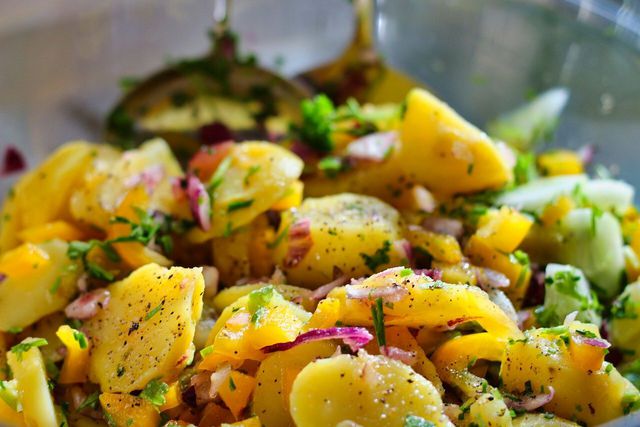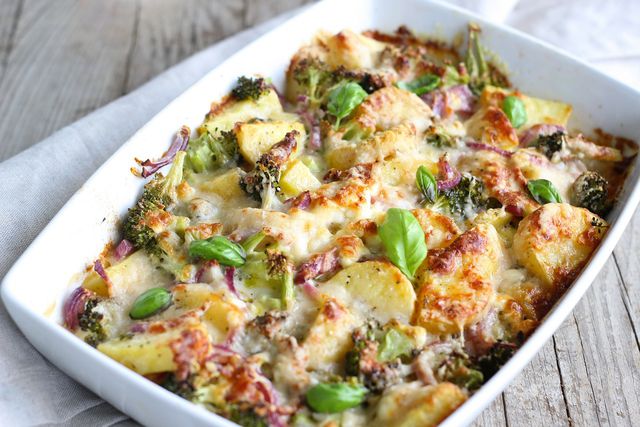If you want to lose weight long-term and healthily, you should try it without starvation and crash diets. Rather try recipes for losing weight that make you full and satisfied and provide you with all the important nutrients!
Our weight loss recipes will help you lose weight in the long term. Because if you want to keep your desired weight in the long term, you should avoid any 14-day diet: starving for a certain period of time not only makes you unhappy, but also causes the “yo-yo effect”, which can even lead to you tend to increase in the end.
When cooking, make sure to include as many vegetables as possible in your diet, but also all the important macronutrients. Strictly avoiding carbohydrates or fat is not only ineffective, but can also have a negative impact on your health. Instead, aim for a balanced ratio of complex carbohydrates, good fats and proteins. This is how you create filling and healthy meals and will lose weight in the long term without going hungry. You can include these three healthy recipes in your repertoire for a balanced diet:
Recipe for losing weight: Fresh potato salad

Secretly a superhero for being able to lose weight without starving yourself: Potatoes are often incorrectly referred to as fattening foods due to their carbohydrate content. In fact, unlike rice, pasta or bread, potatoes have significantly fewer carbohydrates and calories. For example, potatoes in 100 grams have just 70 kilocalories, while cooked pasta has twice as many calories.
Since potatoes also consist of complex carbohydrates and contain some fiber, they are very filling and also provide you with many important vitamins and minerals.
For three servings of potato salad you need:
850 g waxy potatoes
2 onions
2 tbsp canola oil
120 ml (homemade) vegetable broth
3 tablespoons white wine vinegar
1/2 teaspoon medium hot mustard
1/2 cucumber
1 red pepper
150 g cherry tomatoes
1/2 bunch spring onions
2 sprigs of parsley
Salt pepper
How to do it:
Wash the potatoes and then boil them for about 20 minutes.
Peel the onions and cut them into small cubes.
Heat the oil in a pan and sauté the onions for about three to five minutes.
Pour in the vinegar, broth, and mustard and let the mixture simmer for two minutes.
Drain the potatoes and let them cool slightly. Then peel them and cut them into small pieces.
Place the potatoes in a large bowl and pour the mustard and vinegar mixture over them. Then let it steep for at least two hours.
Wash the cucumber and peppers and cut the vegetables into small pieces.
Wash the tomatoes and halve or quarter them.
Wash the spring onions and cut them into fine rings.
Chop the parsley.
Add the vegetable pieces and the parsley to the potatoes and mix all the ingredients together well. Season with salt and pepper.
Tip: When buying the products, pay attention to organic quality. In this way you ensure that the food in the recipe is not contaminated with chemical-synthetic pesticides, which can harm not only the environment but also your health. Not only do you lose weight without starving, it also does other things good for your body.
Chickpea pan with creamy mushroom and spinach sauce for losing weight without feeling hungry
Chickpeas and peas keep you full for a long time thanks to a mix of vegetable proteins, complex carbohydrates and fiber and are therefore a great diet recipe. This effect is enhanced by the healthy fatty acids from nuts and pumpkin seeds. In addition, due to the high proportion of vegetables in this dish, you can eat a relatively large portion that still has few calories for a full meal.
For two servings you need:
1 onion
1 clove of garlic
1 tbsp canola oil
200 grams of mushrooms
1 medium zucchini
1/2 tsp dried thyme
300 g spinach leaves (fresh or frozen)
150 g green peas (frozen)
3 teaspoons cashew or white almond butter
1/2 lemon
350 g chickpeas (cooked)
Salt pepper
2 tbsp yeast flakes
a handful of pumpkin seeds
That’s how it’s done:
Peel the onion and garlic and chop both into small cubes.
Heat the oil in a large pan and fry the onion and garlic pieces for about three minutes.
Clean the mushrooms and wash the zucchini.
Halve the zucchini lengthwise and cut both parts into semi-circular pieces.
Slice the mushrooms.
Add the veggies to the pan with the thyme and stir-fry. If you are using frozen spinach, you should add it now.
Let the vegetables cook for about 5 minutes, until the mushrooms have wilted and the zucchini pieces are still al dente.
Add the frozen peas and cook for another 2-3 minutes until thawed.
Mix the nut butter with the lemon juice and about a tablespoon of water in a small bowl to form a creamy sauce. If it’s still too firm, you can add a little more water.
Place the chickpeas in a colander, rinse with water and drain well.
Then add them to the veggies in the pan.
Now stir the creamy sauce into the chickpea pan. Season with salt and pepper.
Divide the dish between two plates and refine it with yeast flakes and pumpkin seeds.
Recipe for losing weight without feeling hungry: light vegetable casserole

You can also eat a relatively large portion of this dish, as the meal mainly consists of vegetables and is therefore relatively low in calories. In addition, broccoli, carrots, potatoes and tomatoes provide you with important micronutrients.
For two servings you need:
500g broccoli
400 grams of carrots
300 g potatoes (waxy)
1 onion
1 tbsp olive oil
1 tbsp tomato paste
500 ml tomato passata
Salt pepper
1 tsp honey alternative, organic honey or date syrup or sugar
4 sprigs of thyme
200 g grated (vegan) cheese
2 tbsp breadcrumbs
That’s how it’s done:
wash the vegetables Then cut the broccoli into small florets. Peel (if you like) the carrots and potatoes and cut them into slices.
Peel the onion and chop it into small cubes.
Heat the oil in a large saucepan and sauté the onion pieces for three minutes.
Add the tomato paste and let it roast for two minutes.
Deglaze with the tomato passata. Season with salt, pepper and honey and stir the ingredients into a homogeneous sauce.
Pluck off the thyme leaves and chop them into small pieces. Add this to the tomato sauce and let it boil briefly.
Add the vegetable pieces and let the mixture simmer for about seven minutes.
Then put them in a casserole dish and sprinkle with cheese and breadcrumbs.
The casserole is now placed in the oven at 165 degrees Celsius for about 25 minutes. You don’t need to preheat the oven for this.
Tip: If you want to lose weight in the long term without starving yourself, pay close attention to your body’s signals: Only eat when you’re really hungry and stop eating when you’re full. You should also make sure to eat slowly and calmly. You can also avoid the unnecessary fat and sugar in finished products with these three and other recipes, for example breakfast for weight loss.



